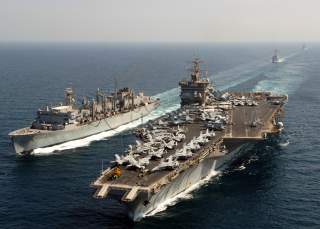Trump's Massive Navy May Take 30 Years to Build
Blame time and money.
The Trump administration’s goal of fielding a 350-ship navy will take at least three decades, according to a senior U.S. Navy official.
Speaking at the NDIA Expeditionary Warfare Conference in Annapolis in late October, Thomas Dee, acting Under Secretary of the Navy, said “It’s going to take a long time” to build a 350-ship navy. “It’s going to take a lot of money.”
“We can be on the mark by mid-century,” Dee added, according to U.S. Naval Institute News, which first reported his comments.
Dee explained that the main constraint to building a 350-ship navy was money. In particular, he cited the fact that the U.S. Navy and other military services have had to contend with a decade of continuing resolutions instead of budgets, as well as the spending restrictions of the Budget Control Act (BCA). The Congressional Research Service has said that the BCA limits reduce defense “spending for the decade (FY2012–FY2021) by about 14 percent or $860 billion compared to continuing the FY2011 enacted level in real terms.”
Recommended: Why North Korea's Air Force is Total Junk
While some of the BCA spending cuts were offset by funds allocated under the overseas contingency operations (OCO) account, this money has impacted the navy’s ability to plan since it’s not guaranteed year-after-year. Continuity is especially important for an area like ship building, which requires extensive planning given that ships take five to seven years to build and programs stretch across decades. Thus, OCO funds can’t be used to sign long-term contracts with shipbuilders.
Recommended: Why Doesn't America Kill Kim Jong Un?
Funding is not the only impediment that Dee identified, however. Even if Congress could get the budgetary issues squared away, Dee said the Pentagon does not believe industry has the capacity to ramp up ship-building fast enough to meet the demands of a 350-ship navy before mid-century. In particular, he highlighted industry’s inability to attract and retain skilled workers.
Recommended: The F-22 Is Getting a New Job: Sniper
Dee’s comments seemed to contradict the Trump administration’s position. During the campaign, candidate Trump pledged: “We will build a Navy of 350 surface ships and submarines, as recommended by the bipartisan National Defense Panel—we have 276 ships now.” In a speech aboard the USS Gerald Ford aircraft carrier in March of this year, President Trump promised to field twelve aircraft carriers as part of his massive naval modernization.
Not surprisingly, then, Dee’s boss, Navy Secretary Richard Spencer, quickly refuted his statements. Appearing on Hugh Hewitt’s MSNBC show, Spencer said that the promise of a 350-ship navy “is still there, and as secretary of the Navy, I’m working on that goal.” He added: “Mr. Dee, unfortunately, being an acting placeholder, I don’t know whether he was speaking for his own accord, but this is one more reason we need to get our politically appointed people in the Pentagon and working for us.”
Notably, Spencer was less enthusiastic during his confirmation hearing, repeatedly deferring questions about whether he supports the president or navy’s vision for a much larger fleet (the navy has said it needs 355 ships). “What I will tell you is that whether it's a 355-ship or not, what we also want to get our head around is, can we have a capacity number but have a capability that's even greater than that, so have the capability of a 355 that might be a 300-ship Navy,” Spencer said at the July hearing. Even when refuting Dee’s claims on the Hugh Hewitt show, Spencer expressed skepticism that the 350-ship navy is attainable within the next decade. Specifically, he called that timeline “pretty aggressive.” Spencer also noted that his team is still exploring what the future makeup of the navy should look at, and singled out unmanned vessels as an area of growth.
Others are more optimistic about reaching a 350-ship navy. In an article in Politico magazine in April of this year, Jerry Hendrix and Robert C. O’Brien argued: “We believe Trump can reach his goal of a highly capable 350-ship fleet by the end of his second term if bold action is taken now.” Among their recommendations was extending the life of ships currently scheduled to be decommissioned, reviving vessels currently in the U.S. Navy’s reserve fleet, as well as building additional carriers, submarines and even frigates based on European designs, among other steps.
Two admirals from Naval Sea Systems Command (NAVSEA) endorsed a similar plan in August, arguing that the navy could reach 355 ships by 2030 through a combination of extending the service lives of vessels currently slated for decommission and accelerating the construction of new ships. On the other hand, the Congressional Budget Office (CBO) estimated that the navy could not reach a 355-ship level before 2035, but that was based on the premise that the navy would only rely on new ships without extending the service lives of existing vessels. Notably, the CBO estimate said seventy-three to seventy-seven more ships would need to be built compared with the navy’s FY 2018 thirty-year shipbuilding plan to reach a 355-ship navy and maintain it for forty years.
Thus, Dee’s assessment is far more pessimistic than the general consensus, although it was unclear if he was accounting for extending the service life of current ships. Still, that does not mean he’s wrong, especially given the massive delays huge defense acquisition often face.
Zachary Keck (@ZacharyKeck) is a former managing editor of The National Interest.
Image: U.S. Navy.

